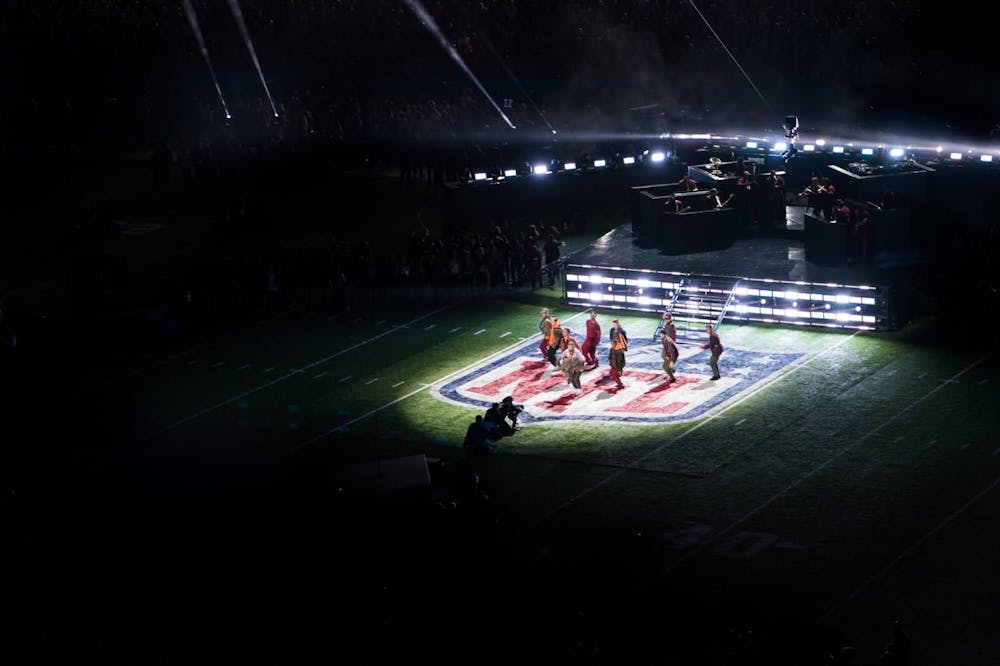By Lake DiStefano
Staff Writer
In recent years, the Super Bowl halftime show has become one of the last pillars of a unified public. Events that once captured a sense of mystique that people so desperately crave have now faded with the access social media provides.
Awards and fashion shows are not as interesting to people as they used to be, especially since they can be comfortably viewed at a later date. Because the Super Bowl halftime show has remained a staple, annual event, it guarantees a near-nationwide audience.
There have been a plethora of iconic and memorable performances that have taken place on that fabled stage. Acts performed by Michael Jackson and Prince come to mind when thinking about the sheer performance power previously displayed within that brief intermission.
The halftime show has rightfully gained a legacy as being a huge honor for the artist chosen. It’s a moment to showcase their talents to the whole country. As far as testaments to one’s artistic ability go, successfully swaying the audience at the Super Bowl is perhaps the pinnacle.
That is why the task is regarded as both rewarding and treacherous. Any mistake made—take Janet Jackson’s wardrobe malfunction in 2004, for example—is essentially witnessed by the entire country.
A successful halftime show is a complicated formula of varying factors. Given how many different types of artists there are, between genre and performance styles, it seems reasonable to assume there is no clear way to do it.
Despite being implemented for the explicit purpose of maintaining viewership during the break, many have failed to successfully pull off what the halftime show tries to be. Capturing interest is hard, especially when carnal desires such as bathroom breaks and snack refills are difficult to compete with.
I’d argue, however, that despite the interchangeable aspects of the various halftime shows, all the truly iconic ones have three key factors in common—factors that ensure that a performance will be successful, or in other words, memorable.
The first of these is the hits required to even be considered in the first place. Take Rihanna’s 2023 halftime show, for example. Even before her show aired, people were accurately predicting what songs she would sing, simply because of how many known hits she had.
Since the show is being aired to almost all of America, including those not intimately familiar with one’s discography, an artist must have enough hits to keep the viewer engaged. They need to have people pointing at their TV, saying “Oh, I know that song,” and singing along to lyrics they seem to know instinctively.
Without the proper amount of recognizable hits, viewers either stop watching or only engage with the performance from a removed perspective. Both are fatal to the performance’s legacy, as not being memorable achieves the same effect as an outright poor performance.
If people aren't talking about it the next day, at work or school, then an artist simply didn’t succeed.
The next key factor is one’s celebrity status as an artist. Having notoriety is crucial, as an artist needs people to know who they are long before they get on the stage. People should recognize their name, since otherwise, the willingness to spend halftime watching the performance dwindles significantly.
People aren’t going to pay attention if they barely know who’s performing. Most of the excitement around the show is created in the weeks leading up to the day. If people don’t know a celebrity well enough to talk about them beforehand, then effectively all hype is killed.
The last factor of a successful halftime show is the stage presence that can be wielded by the performer. A perfect example of a lack of such presence was exemplified in Coldplay’s 2016 halftime show.
It is not uncommon for the leading act to outsource some of the showmanship labor by having guests during their performance. Coldplay brought out both Beyoncé and Bruno Mars during their set, and the official video of their performances has millions more views than Coldplay’s.
Through no fault of their own, Coldplay simply wasn’t engaging on-screen. At least, not in comparison to Beyoncé and Bruno Mars. Many struggle to even recall that it was their show to begin with, as they were so completely overshadowed by their guests.
There is nothing more electrifying than a performer at the peak of their game, whether it be an athlete or a pop star. So despite how difficult it is for one performer to maintain all three of those key factors, as one of the few remaining cultural events left, one can only hope that the halftime show continues to produce legendary performances.







